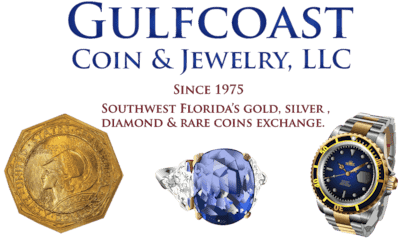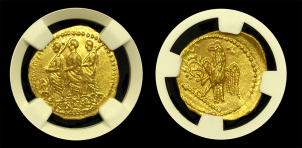
Coson, After 54 B.C., AV Stater, Obv Procession
Featured Rare Coin in August 20, 2022 Online Coin, Paper Money, Ancient Auction
View Online Catalog - Click Here
This ancient coin, known as a Koson (Coson) stater, has inspired a considerable amount of numismatic debate. Studies of these coins from large caches (first uncovered in 16th century Romania) have provided some clues, and it is generally accepted that they were produced mid 1st century BC somewhere in the vicinity of Thrace. Other important questions, such as who minted the coins and for what purpose, are still being answered.The designs on the coin resemble Roman Republican ones of the period, particularly those of Marcus Junius Brutus. On the obverse are three men, wearing togas, walking to the left, two of them carrying objects over their shoulders. The figures bear a striking resemblance to Roman lictors (bodyguards) carrying fasces (axe-like weapons). In exergue is the enigmatic epithet KOSON. On the verso, an eagle stands on a scepter, facing to the left, its right claw raised and holding a wreath.
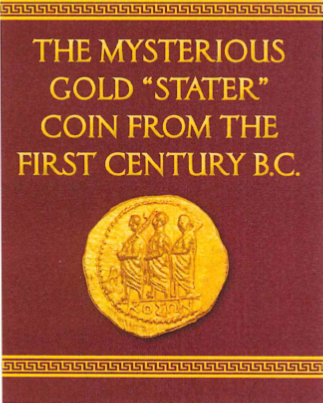 There are two leading (and not necessarily mutually exclusive) theories for the coins’s origin. The first is that was issued by Brutus, who fled to Greece after Caesar’s assassination and used his enormous wealth and/or funds from the Senate to produce these coins to raise an opposing army, and perhaps he was enlisting the help of a local king name Koson. An alternate theory, which has gained favor over time, is that the coin was issued in Trace or Dacia by a king called Koson, who was inspired by Brutus’ designs.
There are two leading (and not necessarily mutually exclusive) theories for the coins’s origin. The first is that was issued by Brutus, who fled to Greece after Caesar’s assassination and used his enormous wealth and/or funds from the Senate to produce these coins to raise an opposing army, and perhaps he was enlisting the help of a local king name Koson. An alternate theory, which has gained favor over time, is that the coin was issued in Trace or Dacia by a king called Koson, who was inspired by Brutus’ designs.
There are lines of logic that support both theories. To add to the controversy, two versions of the coin have been found, those with a mysterious BR monogram on the obverse, and those without. It has been postulated that the BR may refer to Brutus, or alternatively to BA(sileus), i.e, king, as in King Koson; however, there are no records of a King by that name (although there was a King Kotison). Recently, both monogrammed and non-monogrammed versions of these Koson staters were examined for their composition. These studies provided a highly sensitive elemental fingerprint for each coin. It was found that all coins without the monogram were made from native alluvial gold (for example, all had trace amounts of tin), the same composition that was found for other Dacian gold artifacts, i.e., bracelets, that were made at the time. In contrast, all the coins with the BR monogram lacked tin, and were of highly purified gold. This finding leads to an intriguing possibility: the coins with the BR monogram were produced by Brutus using highly refined gold, and later the non-monogrammed coins were imitations made by Thracians or Dacians using their own methods and local alluvial gold.
Lot 1805 The Mysterious Gold “Stater” coin from the First Century B.C., unknown king Cason, who probably ruled part of Thrace.
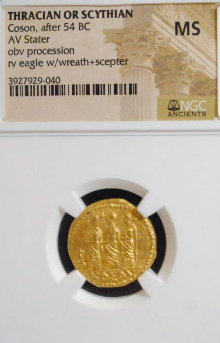
Brutus was the infamous principal assassin of Roman Emperor Julius Caesar on the Ides of March in 44 B.C. The gold for the coins would have come from a treasure awarded to Brutus by the Roman Senate following the assassination. Brutus, in turn, may have used the gold to pay his troops to defend Rome against forces loyal to Julius Caesar. Interestingly, Brutus was the moneyer in charge of the Roman mint in 54 B.C., when he oversaw the production of a similar coin design showing four soldiers.
The back of the gold stater features an eagle, which was a symbol of the ancient Roman army. Standing on a scepter, the eagle holds a wreath in its talons to indicate government authority. The use of the eagle on the back also indicates the military reason for the coin and its possible connection to Brutus.
More than 1,900 years later in the early 1900's, President Theodore Roosevelt inspired the redesign of America's gold coins by pointing out the magnificent and timeless images from ancient coins such as the Coson gold stater. In fact, the eagle on the reverse J of a few U.S. gold coins bears a striking resemblance.
Each Coson gold stater was individually struck by skilled moneyers. To create the coin, a gold planchet was placed between the hand-carved dies, and the top die was hand-struck with a large hammer to transfer the images to the coin. No machinery was involved, so each coin is a slightly different shape, and the design is slightly different from all others.
In the 15OO's, a hoard of mysterious gold stater coins was found in Transylvania, a region in present-day Romania that is renowned for its medieval towns and the legend of the vampire Count Dracula. The coins were about 1,500 years old when found, since they dated to the first century B,C.
Although nobody knows exactly where these gold coins were struck, or by whom, experts believe they were made in southern Europe in Scythia (Modern Ukraine) or, more likely, Thrace (modern Northern Greece). The design, however, was almost certainly inspired by Roman coins of the first century B.C., which adds to the puzzle of their secretive origin.
Scythia was well known to the ancient Greeks and Romans, because it was close to Greek citystates on the Black Sea and was involved in active trade with the Greco-Roman civilization. Due to the many traders in the region, Greco-Roman customs were often observed, and Greek and Roman coins would have been common.
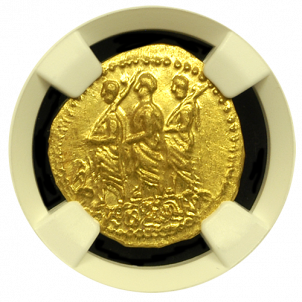
Thrace, which borders the western Black Sea, was part of ancient Greece. It is mentioned in the poet Homer's epic poem Iliad from about the eighth century B.C. Thrace was also the legendary birthplace of Thrax, the son of Ares, the Greek god of war.
The gold stater was a standard denomination for Greek gold coins of that era, but this coin straddles both the ancient Greek and Roman civilizations. Most gold coins from before the birth of Christ more than 2,000 years ago can be identified by the designs, which usually refer to specific cities or rulers. In ancient Greece, for example, each city state struck its own unique coins, such as those from Athens that included symbols of Athena, the patron goddess and namesake of the city.
The front of this gold stater depicts three armed soldiers and the Greek inscription "KOHON" ("Cason"). While the name Cason is not recorded elsewhere in history, scholars believe the coin may have been struck on the orders of Roman politician Brutus to pay troops provided to him by the Senate


 There are two leading (and not necessarily mutually exclusive) theories for the coins’s origin. The first is that was issued by Brutus, who fled to Greece after Caesar’s assassination and used his enormous wealth and/or funds from the Senate to produce these coins to raise an opposing army, and perhaps he was enlisting the help of a local king name Koson. An alternate theory, which has gained favor over time, is that the coin was issued in Trace or Dacia by a king called Koson, who was inspired by Brutus’ designs.
There are two leading (and not necessarily mutually exclusive) theories for the coins’s origin. The first is that was issued by Brutus, who fled to Greece after Caesar’s assassination and used his enormous wealth and/or funds from the Senate to produce these coins to raise an opposing army, and perhaps he was enlisting the help of a local king name Koson. An alternate theory, which has gained favor over time, is that the coin was issued in Trace or Dacia by a king called Koson, who was inspired by Brutus’ designs.
 Thrace, which borders the western Black Sea, was part of ancient Greece. It is mentioned in the poet Homer's epic poem Iliad from about the eighth century B.C. Thrace was also the legendary birthplace of Thrax, the son of Ares, the Greek god of war.
Thrace, which borders the western Black Sea, was part of ancient Greece. It is mentioned in the poet Homer's epic poem Iliad from about the eighth century B.C. Thrace was also the legendary birthplace of Thrax, the son of Ares, the Greek god of war.